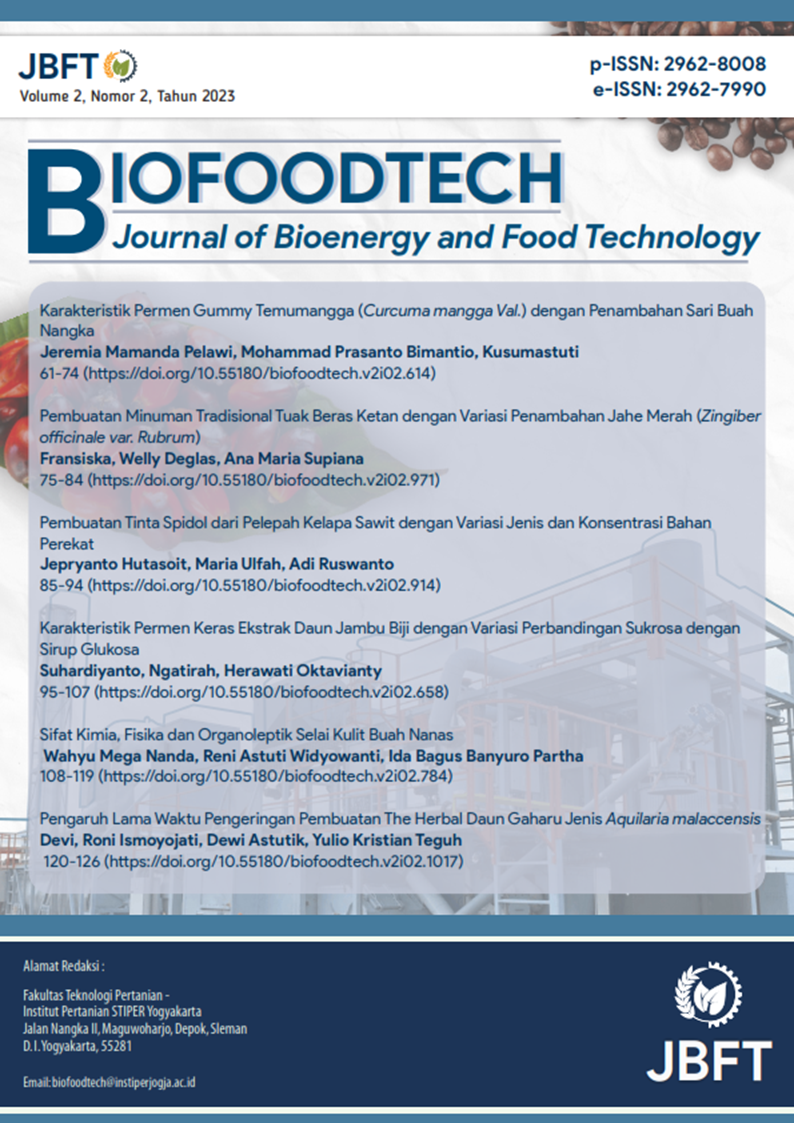Pembuatan Minuman Tradisional Tuak Beras Ketan dengan Variasi Penambahan Jahe Merah (Zingiber officinale var. Rubrum)
DOI:
https://doi.org/10.55180/biofoodtech.v2i02.971Kata Kunci:
traditional drink, sticky rice palm wine, red gingerAbstrak
To determine the effect of adding red ginger to the traditional sticky rice palm wine drink and to determine the alcohol content, dissolved sugar content, and organoleptic in the traditional sticky rice palm wine drink with variations in the addition of red ginger. The research method used was the research design used was a Completely Randomized Design (CRD) with three replications with the addition of red ginger rhizomes, namely with concentration levels of 0%, 50%, 75%, and 100%. In the research, the parameters observed were alcohol content, dissolved sugar content, and organoleptic properties of traditional palm wine drinks sticky rice with a variation of adding red ginger. The addition of red ginger to the traditional drink of sticky rice palm wine has a significant impact on several aspects of the product. Overall, increasing the concentration of red ginger with its antimicrobial and antioxidant properties causes a decrease in alcohol content in palm wine because it can inhibit the fermentation process. The addition of red ginger also reduces the dissolved sugar content and increases the water content in the drink and together reduces the sweet taste of the wine. The addition of red ginger can influence the color of the wine to become more brownish-yellow and increase the aroma of red ginger. Panelists tended to prefer palm wine without the addition of red ginger, possibly because of the distinctive spicy aroma and taste of red ginger which is less popular in this traditional drink.
Referensi
Azizah, N., Al-Barrii, A. N., & Mulyani, S. (2012). PENGARUH LAMA FERMENTASI TERHADAP KADAR ALKOHOL, pH, DAN PRODUKSI GAS PADA PROSES FERMENTASI BIOETANOL DARI WHEY DENGAN SUBSTITUSI KULIT NANAS. Jurnal Aplikasi Teknologi Pangan, 1(3), Article 3. https://jatp.ift.or.id/index.php/jatp/article/view/73
Badan Pengawasan Obat dan Makanan Republik Indonesia (BPOM RI). (2016). Pengaturan Kepala Badan Pengawas Obat dan Makanan Republik Indonesia Nomor 14 Tahun 2016 Tentang SNI Tuak. Badan Pengawasan Obat dan Makanan Republik Indonesia (BPOM RI).
Fakhrudin, M. I. (2008). Kajian karakteristik oleoresin jahe berdasarkan ukuran dan lama perendaman serbuk jahe dalam etanol [Skripsi, Universitas Sebelas Maret]. https://digilib.uns.ac.id/dokumen/7593/Kajian-karakteristik-oleoresin-jahe-berdasarkan-ukuran-dan-lama-perendaman-serbuk-jahe-dalam-etanol
Farrel, R., Aulawi, T., & Darmawi, A. (2020). Quality Analysis of Simplicia Red Ginger (Zingiber officinale Var. Rubrum) Rhizome with Different Drying Temperature. Jurnal Pertanian Tropik, 7(1), Article 1. https://doi.org/10.32734/jpt.v7i1.3866
Gandjar, I., & Sjamsuridzal, W. (2006). Mikologi Dasar dan Terapan. Yayasan Obor Indonesia.
Goldberg, I. (1994). Functional foods: Designer foods, pharmafoods, nutraceuticals. Chapman & Hall.
Savitri, I., Suhendra, L., & Wartini, N. M. (2017). PENGARUH JENIS PELARUT PADA METODE MASERASI TERHADAP KARAKTERISTIK EKSTRAK Sargassum polycystum. Jurnal Rekayasa dan Manajemen Agroindustri, 5(3), 93–101.
Suanda, I. W., & Sumarya, I. M. (2019). Penerapan pembelajaran bioteknologi melalui fermentasi umbi-umbian menjadi produk tape sebagai substitusi pangan beras. Widyadari, 20(1), 111–116.
Wulandari, Y. W. (2009). Karakteristik Minyak Atsiri Beberapa Varietas Jahe (Zingiber officinale). Jurnal Kimia dan Teknologi, 5(1), 43–50.
Unduhan
Diterbitkan
Cara Mengutip
Terbitan
Bagian
Citation Check
Lisensi
Hak Cipta (c) 2023 BIOFOODTECH : Journal of Bioenergy and Food Technology

Artikel ini berlisensiCreative Commons Attribution-NonCommercial-ShareAlike 4.0 International License.











